 |
Copyright is a powerful tool, enabling artists to control performances of their works and collect royalties.  To maximize their fame and income, most composers encourage productions. But, as with most everything else they did, Gilbert and Sullivan took a far different approach, turning to copyright to suppress production and protect their legacy. To maximize their fame and income, most composers encourage productions. But, as with most everything else they did, Gilbert and Sullivan took a far different approach, turning to copyright to suppress production and protect their legacy.
The quirk began with their 1878 smash hit HMS Pinafore. Its first run of 700 London performances crushed the former record for a British-composed theatrical work - and that had been The Beggar's Opera in 1728!  Despite rumors that Americans didn't really speak English, the United States was the second largest market for British theatre. Yet before G&S authorized their first official Pinafore export to the US, dozens of pirate productions already were playing here, including eight simultaneously in New York alone. Despite rumors that Americans didn't really speak English, the United States was the second largest market for British theatre. Yet before G&S authorized their first official Pinafore export to the US, dozens of pirate productions already were playing here, including eight simultaneously in New York alone.
G&S first turned to the law for help. Until an 1886 bilateral treaty provided reciprocity between English and American copyrights, protection here required a separate US application before any domestic publication or performance (authorized or not). 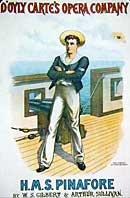 In an effort to comply, through an elaborate ruse G&S snuck their next production, The Pirates of Penzance, into the US to be introduced (and copyrighted) the very same night as the English premiere, before unauthorized presentations could be mounted with purloined librettos and scores. Yet, even once armed with a valid US copyright, enforcement of their Pirates of Penzance against the pirates of America proved impractical. Chauvinistic American judges often refused relief, and even the rare favorable decision arrived far too late to enjoin the huge numbers of illicit productions, which were launched and sustained with impunity. As Sullivan summarized the situation: "It seems to be their opinion that a free and independent American citizen ought not to be robbed of his right of robbing someone else." Even so, they kept trying - the title page of the first US edition of their 1885 Mikado score (still in the Washington, DC Public Library!) provides notice of their US copyright and cautions: "Single detached numbers may be sung at Concerts, not more than two at one Concert, but they must be given without Stage Costumes or Action. … Every copy of this book is is [sic] offered for sale strictly upon the condition that it shall be used only as above." In an effort to comply, through an elaborate ruse G&S snuck their next production, The Pirates of Penzance, into the US to be introduced (and copyrighted) the very same night as the English premiere, before unauthorized presentations could be mounted with purloined librettos and scores. Yet, even once armed with a valid US copyright, enforcement of their Pirates of Penzance against the pirates of America proved impractical. Chauvinistic American judges often refused relief, and even the rare favorable decision arrived far too late to enjoin the huge numbers of illicit productions, which were launched and sustained with impunity. As Sullivan summarized the situation: "It seems to be their opinion that a free and independent American citizen ought not to be robbed of his right of robbing someone else." Even so, they kept trying - the title page of the first US edition of their 1885 Mikado score (still in the Washington, DC Public Library!) provides notice of their US copyright and cautions: "Single detached numbers may be sung at Concerts, not more than two at one Concert, but they must be given without Stage Costumes or Action. … Every copy of this book is is [sic] offered for sale strictly upon the condition that it shall be used only as above."
Failed by the law, G&S turned to self-help by mounting their own productions, an approach that turned out to be far more practical and effective. Given a choice between the real article and a cheap imitation, audiences flocked to appreciate the superior care and talent lavished on the genuine experience.  Beyond a desire to profit by their own labor, it seems that G&S were deeply committed to their artistic goals and standards, as they reportedly turned down generous sums to license independent productions, including $25,000 for the rights to mount The Pirates of Penzance in Boston. Beyond a desire to profit by their own labor, it seems that G&S were deeply committed to their artistic goals and standards, as they reportedly turned down generous sums to license independent productions, including $25,000 for the rights to mount The Pirates of Penzance in Boston.
But piracy wasn't their only problem. Midway through their joint career, friction arose between the two creators. William S. Gilbert was an attorney and prolific author who had written dozens of conventional plays but found equal success with satiric poems and sketches that suggested a vast imagination beneath a surface of staid Victorian propriety. (He once combined his two vocations by successfully suing an adverse critic.) Arthur Sullivan was a gifted composer of whom aristocratic society expected far more of substance than he had yet produced. Their paths first crossed in 1871 when they collaborated on Thespis, a Christmas entertainment for which only Gilbert's words, two songs and a ballet suite survive, as the music was never published and the rest of it remains lost. Four years later, they were reunited by Richard D'Oyly-Carte, a young impresario who longed to launch an English school of light opera but whose immediate need was a half-hour pairing for a short Offenbach operetta he was mounting. With the witty courtroom burlesque of Trial By Jury, writer, composer and producer coalesced into what would become the most powerful creative team English theatre has ever known.
Nowadays, Carte's crucial role is often overlooked. After the success of Trial By Jury, he secured the longevity and services of Gilbert and Sullivan by forming a new opera company that came to be devoted entirely to lavish production of their future work.
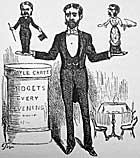
Punch cartoon of D'Oyly Carte balancing his temperamental lyricist and composer |
After squabbles with the outside investors in 1879, he entered into another unique partnership whose profits were to be split evenly, an extraordinary gesture at a time when composers were expected to starve. The company endured twelve years, until foundering in a dispute worthy of one of their absurd plots (whether Carte should charge against the partnership the cost of replacing worn carpets in his theatre). Not only did Carte cement a working relationship between two temperamental individuals and stimulate their creativity, but he set a standard of excellence to showcase their work by creating the Savoy Theatre in 1881, the first in the world to be lit entirely by electricity (powered by an off-site steam generator). Not only were audiences dazzled by the brilliant illumination of the stage but, as ads proudly proclaimed, they were freed from the heat and oxygen depletion of the gas fixtures that dimly lit all other theatres of the time and severely challenged summertime attendance.
Carte's tight control of performance rights (abetted by copyright throughout the British Empire), coupled with his insistence that nothing be changed from the original productions, served functions both useful and damaging.

3 generations of Ko-Kos - Henry Lytton (1920s), George Grossmith (the creator of the role) and Martyn Green (1940s) |
On the one hand, his authorized troupes, the so-called "Savoyards," were a warranty of quality and authenticity. Richard's dynasty continued under the direction of his son Rupert and then grand-daughter Bridget, freezing time to preserve tradition and afford later audiences a unique opportunity to experience an accurate rendition of late Victorian theatre (even though costumes and sets tended increasingly to stray from the originals' realism). Yet, G&S fans were denied the creative input and interpretive updating that could have constantly revitalized their work and made it relevant to new generations rather than relegating it to a curious relic of restricted taste. Artistic quality also may have suffered, as the Savoyard singers had to be a special breed of limited scope and stunted ambition, content to constantly perform the same few roles largely as originally prescribed, rather than attempt to extend their artistry and careers - a daunting prospect that discouraged many who might have enriched the G&S domain with their talent.
The first six G&S operas (Trial By Jury, The Sorcerer, H.M.S. Pinafore, The Pirates of Penzance, Patience and Iolanthe) emerged nearly annually, had contemporary settings in Victorian England, and were all successful.  1884's Princess Ida, though, was a medieval romance (albeit leavened with stabs at the presumed futility of women's education) and a box-office disappointment that tempted the partners to look inward. Stung by criticism that he was wasting his talent on trite popular entertainment and that his work was lapsing into formulaic repetition, Sullivan rejected Gilbert's next libretto (a "lozenge plot" in which comic complications arose from the expedient of character changes wrought by magic pills), which the equally stubborn Gilbert refused to withdraw. Yet they both remained bound to their contracts with Carte. The impasse was resolved only when Gilbert, enamored of the craze for Japanese fashion that was sweeping England, proposed something wholly fresh - a satire on Japanese society, which Sullivan eagerly embraced. (The legend that he was inspired when a Japanese sword fell from its mounting on his wall is generally discredited nowadays.) The plot offered a wonderful opportunity to broaden their customary satire while moving toward the greater romance and spectacle of their remaining collaborations (Ruddigore, The Yeomen of the Guard and The Gondoliers). The opening chorus of noblemen makes it abundantly clear that, despite the exotic setting, strange costumes and stylized gestures, the forthcoming ridicule is meant to fall close to home: 1884's Princess Ida, though, was a medieval romance (albeit leavened with stabs at the presumed futility of women's education) and a box-office disappointment that tempted the partners to look inward. Stung by criticism that he was wasting his talent on trite popular entertainment and that his work was lapsing into formulaic repetition, Sullivan rejected Gilbert's next libretto (a "lozenge plot" in which comic complications arose from the expedient of character changes wrought by magic pills), which the equally stubborn Gilbert refused to withdraw. Yet they both remained bound to their contracts with Carte. The impasse was resolved only when Gilbert, enamored of the craze for Japanese fashion that was sweeping England, proposed something wholly fresh - a satire on Japanese society, which Sullivan eagerly embraced. (The legend that he was inspired when a Japanese sword fell from its mounting on his wall is generally discredited nowadays.) The plot offered a wonderful opportunity to broaden their customary satire while moving toward the greater romance and spectacle of their remaining collaborations (Ruddigore, The Yeomen of the Guard and The Gondoliers). The opening chorus of noblemen makes it abundantly clear that, despite the exotic setting, strange costumes and stylized gestures, the forthcoming ridicule is meant to fall close to home:
If you think we are worked by strings,
Like a Japanese marionette,
You don't understand these things,
It is simply Court etiquette.
In a well-intentioned but misguided instance of diplomacy, in 1907 performances were banned in England to avoid offending visiting Japanese dignitaries, thus strongly suggesting that British leaders may not have fully grasped the true object of Gilbert's satire.
The Mikado was a huge success, both in England and abroad. 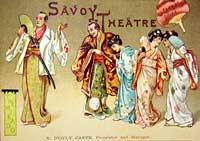 As recounted by H. L. Mencken, by October over 100 theatres were running productions (albeit unauthorized ones) in the US alone, while a vogue for all things Japanese swept the country, from women's kimonos, fans and hair styles to restaurants mistakenly serving chop suey as a Japanese dish. (Interestingly, although a libertarian, Mencken promoted the Mikado as a force for good taste, in contrast to "the rise of slapstick musical comedy, with its obscene jokes, its deafening cacophony and its displays of lingerie," and fervently hoped "such flapdoodle would be forgotten.") Even after the initial intensity subsided, popularity endured as a staple of college and amateur troupes. A second wave of Mikado fever hit in the late 1930s, ranging from a fine D'Oyly Carte Technicolor movie adaptation (complete with "encores" the projectionist could insert) to two all-black productions - a Swing Mikado and a Hot Mikado starring Bill "Bojangles" Robinson. More recent productions have ranged from a Catalonian translation to Der Yiddisher Mikado. As recounted by H. L. Mencken, by October over 100 theatres were running productions (albeit unauthorized ones) in the US alone, while a vogue for all things Japanese swept the country, from women's kimonos, fans and hair styles to restaurants mistakenly serving chop suey as a Japanese dish. (Interestingly, although a libertarian, Mencken promoted the Mikado as a force for good taste, in contrast to "the rise of slapstick musical comedy, with its obscene jokes, its deafening cacophony and its displays of lingerie," and fervently hoped "such flapdoodle would be forgotten.") Even after the initial intensity subsided, popularity endured as a staple of college and amateur troupes. A second wave of Mikado fever hit in the late 1930s, ranging from a fine D'Oyly Carte Technicolor movie adaptation (complete with "encores" the projectionist could insert) to two all-black productions - a Swing Mikado and a Hot Mikado starring Bill "Bojangles" Robinson. More recent productions have ranged from a Catalonian translation to Der Yiddisher Mikado.
The plot is extraordinary, even by Gilbert's standards, yet typical of his "topsy-turvydom" in which absurdity is developed with impeccable logic. Take, for instance, the background tale of the local government.  In reaction to the sovereign Mikado's decree that all who flirt are to be beheaded, the elders of the town of Titipu, fearing their own vulnerability, appoint Ko-Ko the tailor, already condemned, to be Lord High Executioner, as he can't dispatch any of them until he's cut his own head off, which would not only be impossible but a violation of the law against suicide. Unwilling to serve with a former lowly tradesman, the elders' pride compels them to resign their offices, all of which the officious Pooh-Bah assumes, along with all their salaries. However, as Lord High Everything Else, he's conflicted - as Private Secretary he could authorize a lavish wedding, which as Chancellor of the Exchequer he can't permit, although as Paymaster General he could alter the books, but then as Lord High Auditor he would discover the fraud, as Archbishop he would denounce it, and as First Commissioner of Police arrest himself. In reaction to the sovereign Mikado's decree that all who flirt are to be beheaded, the elders of the town of Titipu, fearing their own vulnerability, appoint Ko-Ko the tailor, already condemned, to be Lord High Executioner, as he can't dispatch any of them until he's cut his own head off, which would not only be impossible but a violation of the law against suicide. Unwilling to serve with a former lowly tradesman, the elders' pride compels them to resign their offices, all of which the officious Pooh-Bah assumes, along with all their salaries. However, as Lord High Everything Else, he's conflicted - as Private Secretary he could authorize a lavish wedding, which as Chancellor of the Exchequer he can't permit, although as Paymaster General he could alter the books, but then as Lord High Auditor he would discover the fraud, as Archbishop he would denounce it, and as First Commissioner of Police arrest himself.  Ko-Ko, too, has a problem - he can't hurt a fly, but must execute someone prior to the imminent visit of the macabre Mikado, who naturally expects his high officials to earn their keep. While Pinafore had skewered British class snobbery and Penzance agism, The Mikado tackles the more universal (and highly contemporary) theme of friction between government and human relationships. Ko-Ko, too, has a problem - he can't hurt a fly, but must execute someone prior to the imminent visit of the macabre Mikado, who naturally expects his high officials to earn their keep. While Pinafore had skewered British class snobbery and Penzance agism, The Mikado tackles the more universal (and highly contemporary) theme of friction between government and human relationships.
The story proper finds Ko-Ko in love with his lovely young ward Yum-Yum (great names!), who is enamored of wandering minstrel Nanki-Poo, who, in turn, is being pursued by the aged Katisha. Ko-Ko strikes a bargain, agreeing to let Yum-Yum marry Nanki-Poo if he agrees to be beheaded after one month, after which Ko-Ko's position will be secure and his own plan to wed Yum-Yum will resume. Two problems, though - the intended victim is the Mikado's only son in disguise, and an obscure law requires the widow of one beheaded to be buried alive. Of course, ultimately there's a happy (and thoroughly "topsy-turvy") solution - all agree that, by virtue of his supreme sovereignty, when the Mikado commands that something be done it's as good as done, so why bother actually doing it?
Not to diminish Sullivan's role, but this seems to be one of the few instances in opera where the words outshine the music. (Tellingly, while Gilbert's lyrics are often quoted, suites of Sullivan's music are rare.) Even in his wonderful Pinafore, some rhymes seem forced and prose merely functional. Here, though, every line sparkles. Indeed, Gilbert's text is often so inherently musical as to all but set itself. Thus, a line like "Laughing (ha-ha), chaffing (ha-ha), nectar-quaffing (ha-ha-ha)" all but compels its accompanying melody. Even beyond its abundant wit, consider the internal rhythm of this rapid-fire ditty contemplating the condemned's fate:
To sit in solemn silence in a dull, dark dock
In a penitential prison with a life-long lock,
Awaiting the sensation of a short, sharp shock
From a cheap and chippy chopper on a big, black block.
Once heard, the melodies seem an intractable part of the overall impression. Yet, while the extraordinarily close fit between words and music suggests that the two creators worked intimately, their relationship was rather distant - typically, Gilbert would present a libretto to Sullivan, who would then fashion the music, after which they would collaborate to polish the final form.
While the 17 segments of dialogue, ranging from a few lines to several minutes, are witty but not quite as consistently inspired, Gilbert's lyrics are astounding for their sophistication -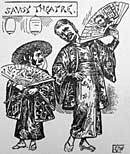 where else would you ever find such rhyme pairs as indulgent/effulgent, seminary/tutelary, hallowed joys/equipoise, or ablutioner/diminutioner? Yet, all sound utterly natural in context. His daring structures are wondrous as well - the "I Am So Proud" trio combines three complementary lines of patter, each tightly rhymed every four syllables. (In Pirates of Penzance, Gilbert seeming tweaks himself when the Modern Major General keeps singing himself into a corner and must struggle to find appropriate rhymes for abstruse words to which he's already committed himself.) where else would you ever find such rhyme pairs as indulgent/effulgent, seminary/tutelary, hallowed joys/equipoise, or ablutioner/diminutioner? Yet, all sound utterly natural in context. His daring structures are wondrous as well - the "I Am So Proud" trio combines three complementary lines of patter, each tightly rhymed every four syllables. (In Pirates of Penzance, Gilbert seeming tweaks himself when the Modern Major General keeps singing himself into a corner and must struggle to find appropriate rhymes for abstruse words to which he's already committed himself.)
Some of the allusions are time-bound and obscure nowadays (such as "Parliamentary trains" - an apparent reference to excruciatingly slow government-subsidized locals). Others, though, remain as universal and cogent as ever ("The idiot who praises with enthusiastic tone / Every century but this and every country but his own"). Since the lyrics were intended to be topical, modern practice occasionally updates the text to retain the intended effect of relevance. One part in particular all but demands contemporary revision - Ko-Ko concludes his little list of society offenders who never would be missed with "Tut-tut-tut and What's His Name and also You-Know-Who" - the original actor, apparently as gifted a mimic as an accomplished singer, was to ply his trade with caricatures of government leaders, and it surely upholds the spirit of the work to do so nowadays.
The Mikado bears the dubious distinction as the only G&S libretto in which the "n-word" appears not just once but twice. Was Gilbert a racist? Perhaps, but he probably was no more insensitive than any other upper-crust Britisher of the time, who was both fascinated and repulsed by anyone whose family tree was fed by earthy roots. Curiously, the first report of any concern arose only in 1948, when Rupert D'Oyly Carte wrote: "We found recently in America that much objection was taken by coloured persons to a word used twice in The Mikado... . Many protests and letters were received." From then on, nearly all performances have substituted on Ko-Ko's list "the banjo serenader and the others of his race," and the society matron who wallows in make-up is punished by being "painted with vigor [rather than 'blacked like a ----'] with permanent walnut juice." Beware, though, if you're apt to be upset, that most pre-stereo recordings retain the original text.
Gilbert not only provided the tight libretto, but served as an equally fastidious stage director. Peter Kline traces the trademark G&S aura of absurdity to the ironic juxtaposition of the clarity of declamation and beauty of gesture of classical theatre,
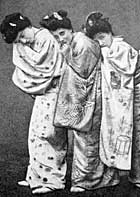
The original Three Little Girls From School - Sybil Grey, Leonora Braham and Jessie Bond |
the realism and craftsmanship of modern drama, and the outsized personality of burlesque (to which perhaps should be added the prudish veneer of the Victorian code of behavior). Charles Hayter notes that Gilbert rehearsed fanatically, insisting upon a consistency of style comprising each detail of stage movement, bodily gesture, facial expression and spoken inflection. He prized articulation to convey the subtleties of his language and held realistic and earnest delivery as the key to relishing the absurdity of his plots; indeed, illogic is only extraordinary in a context of strict logic. His obsession with accuracy led him to hire a Geisha girl from a cultural exhibition in Knightsbridge (known as "Miss Sixpence Please," the only English words she spoke after serving customers their tea) to teach his cast proper Japanese deportment and movement, and to insist that actual Japanese silk be used for all Mikado costumes (some of which were antique kimonos).
As for Sullivan's music, The Mikado is remarkable for its sheer density and sustained quality. A typical opera or musical has at most a dozen or so memorable arias or songs, but The Mikado has over thirty. (The score separately lists 24 numbers, but several are compound; thus, Nanki-Poo's opening song ("A Wandering Minstrel I") has four distinct parts and the first act finale six, any of which could have been developed into a full-blown number of its own.) Significantly, only one is distinctively Japanese - the "Mi-ya Sa-ma" chorus that opens the overture and reappears at the Mikado's entrance is a genuine Imperial army war march. The rest are at least generic (well suited for any of the other G&S shows) and often quintessentially British, including a madrigal, a glee and even a sea chantey. Among the many highlights: "Three Little Maids From School Are We," brimming with youthful glee and mischief; the giddy trio "Here's a Howdy-Do;" the ravishing "The Sun Whose Rays Are All Ablaze;" "The Criminal Cried," in which Ko-Ko, Pitti-Sing and Pooh-Bah each embellish their fictitious tale of an execution according to their own pretension; Katisha's heart-rending "Alone and Yet Alive;" Ko-Ko's absurd tale of heartbreak, "Tit-Willow;" and his ecstatic duet with Katisha, "There is Beauty in the Bellow of the Blast."
The extraordinary century-long history of Mikado recordings was paved by Sullivan himself a mere three years after the premiere. In one of the earliest surviving Edison cylinders, made at an October 1888 dinner toast in London, Sullivan reacted to a demonstration of the new invention with both humor and startling prescience:
I am astonished and somewhat terrified at the results of this evening's experiment - astonished at the wonderful power you have developed and terrified at the thought that so much hideous and bad music may be put on record forever. But all the same, I think it is the most wonderful thing that I have ever experienced and I congratulate you with all my heart on this wonderful discovery.
What a fine prognosis of the future recording industry!
As a tribute to its popularity, The Mikado was the first of the G&S operas to be recorded in full, although many individual numbers preceded it. Of these, the most important is "A More Humane Mikado" cut in 1902 by Richard Temple, who had created the role (and for whom the part was customized).

Richard Temple
The first Mikado |
Indeed, he's the only member of the original cast to have made any records. The result is surprisingly ordinary and casual, often blurring the rhythmic distinction between quarter and eighth notes and departing from the score only to add a slight embellishment on "billiard," but perhaps suggests a pervasive wry subtlety in the original production. (In contrast, Walter Passmore, arguably the most important G&S actor of the second generation, recorded an ostentatious "Tit Willow" in 1912 that often departs from the score with falsetto and even a final cadenza. However, by then he had left the company, so perhaps was asserting his independence from Gilbert's stifling exactitude.)
Long before most operas received their first recordings, catalogues boasted several Mikados. As documented by Marc Shepherd in his superb on-line G&S discography, nearly complete sets were issued by HMV in 1906, G&T in 1907, Edison Bell in 1912 and HMV again in 1917. Although all but the Edison were authorized by Carte, nearly all the roles were taken by studio artists having no connection to his company and there was little pretense of continuity, with roles often cast with different singers in separate songs.
Only in 1926 did the first credible and genuine Mikado emerge on disc, with nearly all roles taken by current D'Oyly Carte stars.  Although the technical quality of the early electrical recording is disappointingly dim and thin, and some of the words are hard to discern, the set richly deserves its reputation as the finest Mikado on record, hinting at human aspirations beneath the stylized patina, never threatening to take itself either too rapturously or too seriously, and nestled within a propulsive yet yielding orchestral setting led by Harry Norris. Above all are its vibrant personalities and confident delivery suffused with natural restraint that add humanizing complexity to the basic characters. Thus, the legendary Henry Lytton delivers Ko-Ko's lines with conversational ease, even as his nasal bleating suggests an internal battle between desperation and snobbery (and superbly illustrating Gilbert's aesthetic of letting the comedy emerge from a dead-serious demeanor), Bertha Lewis's deep and lush Katisha is domineering yet painfully vulnerable, Derek Oldham's Nanki-Poo is smooth but ardent, Darrell Fancourt's Mikado pursues his warped vision of justice with singular abandon, Leo Sheffield's Pooh-Bah tempers his brash arrogance with meticulous diction, and Elsie Griffith's Yum-Yum swells as the school-girl's naïve wonder yields to the feminist pride of her budding romance in the gorgeous "The Sun Whose Rays" aria. Although the technical quality of the early electrical recording is disappointingly dim and thin, and some of the words are hard to discern, the set richly deserves its reputation as the finest Mikado on record, hinting at human aspirations beneath the stylized patina, never threatening to take itself either too rapturously or too seriously, and nestled within a propulsive yet yielding orchestral setting led by Harry Norris. Above all are its vibrant personalities and confident delivery suffused with natural restraint that add humanizing complexity to the basic characters. Thus, the legendary Henry Lytton delivers Ko-Ko's lines with conversational ease, even as his nasal bleating suggests an internal battle between desperation and snobbery (and superbly illustrating Gilbert's aesthetic of letting the comedy emerge from a dead-serious demeanor), Bertha Lewis's deep and lush Katisha is domineering yet painfully vulnerable, Derek Oldham's Nanki-Poo is smooth but ardent, Darrell Fancourt's Mikado pursues his warped vision of justice with singular abandon, Leo Sheffield's Pooh-Bah tempers his brash arrogance with meticulous diction, and Elsie Griffith's Yum-Yum swells as the school-girl's naïve wonder yields to the feminist pride of her budding romance in the gorgeous "The Sun Whose Rays" aria.
D'Oyly Carte's copyright, including the exclusive right to license recordings throughout the British Empire, endured until 1961 (50 years beyond the life of the last surviving author). 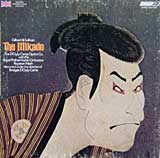 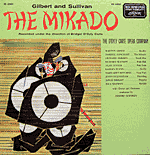 (Deeming the G&S copyrights a national treasure, Parliament considered but ultimately declined to pass a special bill to extend them.) Even beyond the period of protection, D'Oyly Carte had the recording field mostly to itself, issuing Mikado remakes in 1936, 1950, 1957, 1973 and 1990. Artistically, they're quite similar, as they all preserve the same basic wry conception, even including a few performing traditions that depart from the score, such as the Mikado's inflated comic laugh and gasping inhale before each chorus of "My Object All Sublime" (the score indicates only a pause) and deflating Ko-Ko's overwrought line of temporary defeat to Nanki-Poo, "Take her - she's yours," with an aside to Yum-Yum's sister Pitti-Sing of "Not you, silly". Yet, while benefiting from increasingly better sound, all seem progressively bland and devoid of personality compared to the 1926 set. (Deeming the G&S copyrights a national treasure, Parliament considered but ultimately declined to pass a special bill to extend them.) Even beyond the period of protection, D'Oyly Carte had the recording field mostly to itself, issuing Mikado remakes in 1936, 1950, 1957, 1973 and 1990. Artistically, they're quite similar, as they all preserve the same basic wry conception, even including a few performing traditions that depart from the score, such as the Mikado's inflated comic laugh and gasping inhale before each chorus of "My Object All Sublime" (the score indicates only a pause) and deflating Ko-Ko's overwrought line of temporary defeat to Nanki-Poo, "Take her - she's yours," with an aside to Yum-Yum's sister Pitti-Sing of "Not you, silly". Yet, while benefiting from increasingly better sound, all seem progressively bland and devoid of personality compared to the 1926 set.
The first, and for decades only, major challenger to D'Oyly Carte arose in 1957,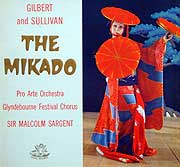 as the copyright was about to expire. Sir Malcolm Sargent, who had conducted most of the first electrical series (but not the Mikado), was intimately familiar with the lithe D'Oyly Carte tradition, yet approached his recording as grand opera. Roles were cast with beautiful voices (Owen Brannigan as the Mikado, Richard Lewis as Nanki-Poo, Geriant Evans as Ko-Ko, Elsie Morrison as Yum-Yum and Monica Sinclair as Katisha) having ample opera credentials but little G&S experience and sung with lots of vibrato and strained articulation. The orchestral playing was richer and more prominent, dynamics more varied, and tempos much more stately - even discounting an extended introduction to the "Miya sama" chorale, the whole thing weighs in at a plodding 90 minutes. Although the lyrical and softer passages are genuinely moving, much of the essential subtlety, irony and satiric edge of the score is lost. Even the "joyous shout and ringing cheer" of the finale seems joyless and labored. (Curiously, the "Miya sama" is sung with a bitterly mocking pinched tone and while one of the "n-words" is changed the other remains.) Yet, the production is treasurable as a meaningful alternative to the D'Oyly Carte stylistic monopoly, which, after all, had served its purpose of perpetuating the authors' intentions to provide a basis for comparison. as the copyright was about to expire. Sir Malcolm Sargent, who had conducted most of the first electrical series (but not the Mikado), was intimately familiar with the lithe D'Oyly Carte tradition, yet approached his recording as grand opera. Roles were cast with beautiful voices (Owen Brannigan as the Mikado, Richard Lewis as Nanki-Poo, Geriant Evans as Ko-Ko, Elsie Morrison as Yum-Yum and Monica Sinclair as Katisha) having ample opera credentials but little G&S experience and sung with lots of vibrato and strained articulation. The orchestral playing was richer and more prominent, dynamics more varied, and tempos much more stately - even discounting an extended introduction to the "Miya sama" chorale, the whole thing weighs in at a plodding 90 minutes. Although the lyrical and softer passages are genuinely moving, much of the essential subtlety, irony and satiric edge of the score is lost. Even the "joyous shout and ringing cheer" of the finale seems joyless and labored. (Curiously, the "Miya sama" is sung with a bitterly mocking pinched tone and while one of the "n-words" is changed the other remains.) Yet, the production is treasurable as a meaningful alternative to the D'Oyly Carte stylistic monopoly, which, after all, had served its purpose of perpetuating the authors' intentions to provide a basis for comparison.
With expiration of the D'Oyly Carte copyright, the way was freed for a bevy of independent Mikado recordings, but surprisingly few followed - mostly a handful of single LP abridgements. (One of the most tempting, a 1986 English National Opera production starring a wry Eric Idle as Ko-Ko, is compromised by slow tempos, a completely rewritten but painfully unfunny "List" song and irksome sweetening of each long "o" so that "so" becomes "sue.") Indeed, the first major undertaking after Sargent's was not until 1990, when yet another D'Oyly Carte set appeared (Sony). (Although the company had disbanded in 1982, it was reformed briefly in 1989.) 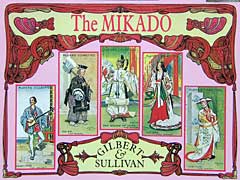 Its final recording claims to be based on the composer's autograph, but the differences with the published score seem slight. The purely musical values of the performance are potent (and a vast rebound from the lackluster 1973 set), but the disarming spirit and fun of the earlier D'Oyly Carte ventures cede to a highly polished and rather generic product. Although both choral and solo singing is thrillingly precise (abetted by the clear recording quality and propelled by stirring tempos), the officials' voices seem too light to suggest pompous egos, the school-girls' are too deep to evoke innocence, and timbres are confusingly similar; one of the few attempts at individuality - the Mikado's raucous laugh - is downright jarring. Yet unlike all the other vocal-dominated recordings, the mix gives full weight to the felicitous scoring of the orchestra, whose contributions for once can be savored, with occasional surprisingly fleet tempos, bold dynamics, nicely audible winds and brass, and bracing tympani accents. Distinctive touches: the first verse of the "Were You Not to Ko-Ko Plighted" duet is restored (although the usual kissing sounds are omitted), the instrumental intro to the Mikado's entrance is repeated, and Ko-Ko's little list is modernized with cute references to portable electronics - "men who wear a wristwatch with an irritating bleep," and "to think that all that awful junk is made here in Japan." The wonderful cover displays Players Tobacco trading cards of the costumed lead roles. Its final recording claims to be based on the composer's autograph, but the differences with the published score seem slight. The purely musical values of the performance are potent (and a vast rebound from the lackluster 1973 set), but the disarming spirit and fun of the earlier D'Oyly Carte ventures cede to a highly polished and rather generic product. Although both choral and solo singing is thrillingly precise (abetted by the clear recording quality and propelled by stirring tempos), the officials' voices seem too light to suggest pompous egos, the school-girls' are too deep to evoke innocence, and timbres are confusingly similar; one of the few attempts at individuality - the Mikado's raucous laugh - is downright jarring. Yet unlike all the other vocal-dominated recordings, the mix gives full weight to the felicitous scoring of the orchestra, whose contributions for once can be savored, with occasional surprisingly fleet tempos, bold dynamics, nicely audible winds and brass, and bracing tympani accents. Distinctive touches: the first verse of the "Were You Not to Ko-Ko Plighted" duet is restored (although the usual kissing sounds are omitted), the instrumental intro to the Mikado's entrance is repeated, and Ko-Ko's little list is modernized with cute references to portable electronics - "men who wear a wristwatch with an irritating bleep," and "to think that all that awful junk is made here in Japan." The wonderful cover displays Players Tobacco trading cards of the costumed lead roles.
The only other relatively recent choice followed the next year from the Welsh National Opera led by Charles Mackerras (Telarc). In nearly all respects, it's strikingly similar to the D'Oyly Carte set, but with occasionally stodgy tempos, more sensitive (and often affected phrasing) and exaggerated pauses and tempo deceleration, all of which tend to abrade the essential light comedic satire of the work.  Among the nice distinctive touches, though, are deafening bass drum rolls as the crowd interrupts Katisha's attempted denunciation (which are authentic - the score marks them fff and specifies use of two sticks), and a big smooch, followed by Yum-Yum's contented sigh, at the culmination of "Were You Not to Ko-Ko Plighted." Only Pooh-Bah projects any sense of character (largely derived from his prissy enunciation) and, ironically, the most famous member of the cast (Felicity Palmer as Katisha) seems the least comfortable with her role. Ko-Ko in particular needs to be comic and pathetic, and without the visual boost of bold costumes or outlandish gestures the inherently droll nasal textures and whiny pitch of the old D'Oyly Carte casts are sorely missed. One significant benefit (and corresponding trade-off) - this is the only Mikado that crams all of its 79+ minutes onto a single disc, although to do so it omits the middle verse of Ko-Ko's list, a minute from the first act finale and the overture (not written by Sullivan but cobbled together from a half-dozen Mikado melodies by his aide Hamilton Clarke), the inclusion of which would have pushed the timing several minutes past the remarkably consistent 84 or so of all the D'Oyly Carte sets. (Yet it's full-priced, and so barely more thrifty than mid-priced two-disc sets.) Kudos to Hilary Knight for splendidly stylized cover art. Incidentally, this and all the other recordings, while musically complete, omit the dialogue. Among the nice distinctive touches, though, are deafening bass drum rolls as the crowd interrupts Katisha's attempted denunciation (which are authentic - the score marks them fff and specifies use of two sticks), and a big smooch, followed by Yum-Yum's contented sigh, at the culmination of "Were You Not to Ko-Ko Plighted." Only Pooh-Bah projects any sense of character (largely derived from his prissy enunciation) and, ironically, the most famous member of the cast (Felicity Palmer as Katisha) seems the least comfortable with her role. Ko-Ko in particular needs to be comic and pathetic, and without the visual boost of bold costumes or outlandish gestures the inherently droll nasal textures and whiny pitch of the old D'Oyly Carte casts are sorely missed. One significant benefit (and corresponding trade-off) - this is the only Mikado that crams all of its 79+ minutes onto a single disc, although to do so it omits the middle verse of Ko-Ko's list, a minute from the first act finale and the overture (not written by Sullivan but cobbled together from a half-dozen Mikado melodies by his aide Hamilton Clarke), the inclusion of which would have pushed the timing several minutes past the remarkably consistent 84 or so of all the D'Oyly Carte sets. (Yet it's full-priced, and so barely more thrifty than mid-priced two-disc sets.) Kudos to Hilary Knight for splendidly stylized cover art. Incidentally, this and all the other recordings, while musically complete, omit the dialogue.
While recordings convey much of the splendor of The Mikado, G&S conceived their work as theatre. 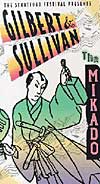 Much of the missing visual element of traditional staging is well preserved and conveyed in the 1939 movie, made under the auspices of the D’Oyly Carte company and featuring its chorus, if not its leads. The sets, costumes and décor (by Vertés) are lavish and dazzling in Technicolor, the acting expressive (including lots of pratfalls by Martyn Green as Ko-Ko) and the singing quite lovely. Yet, this is an adaptation (credited to the conductor, Geoffrey Toye) – even with a ten-minute prologue pantomimed to parts of the overture (and a verse of “The Sun Whose Rays” sung as a serenade by Nanki-Poo to Yum-Yum) it runs only 92 minutes, so nearly a third is cut, including a half-dozen numbers, the “List” song among them, and portions of others.
The attractions and drawbacks of modern adaptation emerge from a CBC video of a 1982 Stratford Festival of Canada production. Among the disappointments are poorly synched miming of prerecorded musical numbers, excision of the bold "See How the Fates" a capella quintet, needless zylophone reinforcement of the orchestration and severely overacted portrayals of the Mikado and Pooh-Bah, the latter resorting to squirm-inducing stereotyping of Japanese mannerisms and speech (turning "l"s into "r"s and lots of "Ah-so"s). Yet the essence of G&S emerges from the non-intrusive direction, lavish costumes offsetting minimal abstract sets (just a few risers and props moved about by tumbling members of the chorus), several numbers extended or encored, choreography that bypasses the customary rigidity for abstract freedom and, for once, a genuinely clever rewrite of the "List" song that complements Gilbert's original with a clever put-down of all those present other than the singers themselves. The lasting impression is that of a deeply-moving tribute to the essential humanity and universality of G&S - proof that The Mikado remains as delightful and touching as ever more than a century after its creation. Much of the missing visual element of traditional staging is well preserved and conveyed in the 1939 movie, made under the auspices of the D’Oyly Carte company and featuring its chorus, if not its leads. The sets, costumes and décor (by Vertés) are lavish and dazzling in Technicolor, the acting expressive (including lots of pratfalls by Martyn Green as Ko-Ko) and the singing quite lovely. Yet, this is an adaptation (credited to the conductor, Geoffrey Toye) – even with a ten-minute prologue pantomimed to parts of the overture (and a verse of “The Sun Whose Rays” sung as a serenade by Nanki-Poo to Yum-Yum) it runs only 92 minutes, so nearly a third is cut, including a half-dozen numbers, the “List” song among them, and portions of others.
The attractions and drawbacks of modern adaptation emerge from a CBC video of a 1982 Stratford Festival of Canada production. Among the disappointments are poorly synched miming of prerecorded musical numbers, excision of the bold "See How the Fates" a capella quintet, needless zylophone reinforcement of the orchestration and severely overacted portrayals of the Mikado and Pooh-Bah, the latter resorting to squirm-inducing stereotyping of Japanese mannerisms and speech (turning "l"s into "r"s and lots of "Ah-so"s). Yet the essence of G&S emerges from the non-intrusive direction, lavish costumes offsetting minimal abstract sets (just a few risers and props moved about by tumbling members of the chorus), several numbers extended or encored, choreography that bypasses the customary rigidity for abstract freedom and, for once, a genuinely clever rewrite of the "List" song that complements Gilbert's original with a clever put-down of all those present other than the singers themselves. The lasting impression is that of a deeply-moving tribute to the essential humanity and universality of G&S - proof that The Mikado remains as delightful and touching as ever more than a century after its creation.
Of the many G&S books, I heartily recommend Leslie Baily's thorough, highly readable and profusely illustrated Gilbert and Sullivan Book (Cassell & Company, 1952). 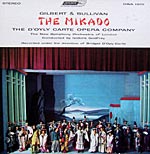 Far more brief, yet filled with insight, is Charles Hayter's Gilbert and Sullivan (MacMillan, 1987). Peter Kline's The Theatre Student - Gilbert & Sullivan Production (Richards Rose Press, 1972) combines a good overview with reflections on practical considerations on mounting the operas. Two websites are of great value - Marc Shepherd's exhaustively annotated discography and the vast resources of Jim Farron and Paul Howarth's Gilbert and Sullivan Archive, which includes libretti, posters, photos and the complete music in MIDI files. Indeed, Mr. Shepherd kindly provided many helpful comments and corrections for this article, which now benefits from his extensive knowledge. The full libretto is also available with annotations that explain now-obscure references and provide performance details in Ian Bradley's The Complete Annotated Gilbert and Sullivan (Oxford University Press, 1996) and Martyn Green's Treasury of Gilbert and Sullivan (Simon & Schuster, 1961); the latter includes 16 of the Mikado songs arranged for voice and piano and profits from Green's extensive tenure as a D'Oyly Carte principal - he estimates that he gave 1500 performances as Ko-Ko and he can be heard in that role in the 1950 LP set. Finally, Michael Leigh's superb 1999 movie Topsy-Turvy focuses upon the creation of The Mikado and derives profound insight into the meaning of art with a combination, rare for biopics, of dramatic effectiveness and historical accuracy (the only contrivance being the falling sword canard as the inspiration for The Mikado) - the actors portraying not only Gilbert, Sullivan and Carte, but even the stars of the original production, are dead ringers for the historical figures. Although the singing tends to be rather crude and tempos turgid, eight of the Mikado songs (and several more from predecessor works) are lavishly mounted and the movie ends on a poignant and wistful note, as Gilbert, Sullivan and an actress are all ever so subtly transformed by the premiere, as have countless millions ever since. Far more brief, yet filled with insight, is Charles Hayter's Gilbert and Sullivan (MacMillan, 1987). Peter Kline's The Theatre Student - Gilbert & Sullivan Production (Richards Rose Press, 1972) combines a good overview with reflections on practical considerations on mounting the operas. Two websites are of great value - Marc Shepherd's exhaustively annotated discography and the vast resources of Jim Farron and Paul Howarth's Gilbert and Sullivan Archive, which includes libretti, posters, photos and the complete music in MIDI files. Indeed, Mr. Shepherd kindly provided many helpful comments and corrections for this article, which now benefits from his extensive knowledge. The full libretto is also available with annotations that explain now-obscure references and provide performance details in Ian Bradley's The Complete Annotated Gilbert and Sullivan (Oxford University Press, 1996) and Martyn Green's Treasury of Gilbert and Sullivan (Simon & Schuster, 1961); the latter includes 16 of the Mikado songs arranged for voice and piano and profits from Green's extensive tenure as a D'Oyly Carte principal - he estimates that he gave 1500 performances as Ko-Ko and he can be heard in that role in the 1950 LP set. Finally, Michael Leigh's superb 1999 movie Topsy-Turvy focuses upon the creation of The Mikado and derives profound insight into the meaning of art with a combination, rare for biopics, of dramatic effectiveness and historical accuracy (the only contrivance being the falling sword canard as the inspiration for The Mikado) - the actors portraying not only Gilbert, Sullivan and Carte, but even the stars of the original production, are dead ringers for the historical figures. Although the singing tends to be rather crude and tempos turgid, eight of the Mikado songs (and several more from predecessor works) are lavishly mounted and the movie ends on a poignant and wistful note, as Gilbert, Sullivan and an actress are all ever so subtly transformed by the premiere, as have countless millions ever since.

Copyright 2006 by Peter Gutmann
|

 As recounted by H. L. Mencken, by October over 100 theatres were running productions (albeit unauthorized ones) in the US alone, while a vogue for all things Japanese swept the country, from women's kimonos, fans and hair styles to restaurants mistakenly serving chop suey as a Japanese dish. (Interestingly, although a libertarian, Mencken promoted the Mikado as a force for good taste, in contrast to "the rise of slapstick musical comedy, with its obscene jokes, its deafening cacophony and its displays of lingerie," and fervently hoped "such flapdoodle would be forgotten.") Even after the initial intensity subsided, popularity endured as a staple of college and amateur troupes. A second wave of Mikado fever hit in the late 1930s, ranging from a fine D'Oyly Carte Technicolor movie adaptation (complete with "encores" the projectionist could insert) to two all-black productions - a Swing Mikado and a Hot Mikado starring Bill "Bojangles" Robinson. More recent productions have ranged from a Catalonian translation to Der Yiddisher Mikado.
As recounted by H. L. Mencken, by October over 100 theatres were running productions (albeit unauthorized ones) in the US alone, while a vogue for all things Japanese swept the country, from women's kimonos, fans and hair styles to restaurants mistakenly serving chop suey as a Japanese dish. (Interestingly, although a libertarian, Mencken promoted the Mikado as a force for good taste, in contrast to "the rise of slapstick musical comedy, with its obscene jokes, its deafening cacophony and its displays of lingerie," and fervently hoped "such flapdoodle would be forgotten.") Even after the initial intensity subsided, popularity endured as a staple of college and amateur troupes. A second wave of Mikado fever hit in the late 1930s, ranging from a fine D'Oyly Carte Technicolor movie adaptation (complete with "encores" the projectionist could insert) to two all-black productions - a Swing Mikado and a Hot Mikado starring Bill "Bojangles" Robinson. More recent productions have ranged from a Catalonian translation to Der Yiddisher Mikado.